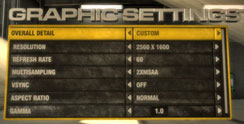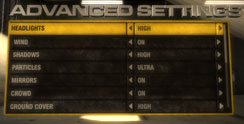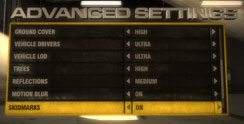Palit Revolution 700 (Radeon HD 4870 X2)
Written by Harry Butler
January 13, 2009 | 08:30
Tags: #4870 #4870-x2 #4870x2 #cooler #hd4870x2 #r700 #radeon #revolution #rv770 #testing #triple #triple-slot
Companies: #palit

Race Driver: GRID
Publisher: CodemastersRace Driver: GRID is one of the best racing games to grace the PC in some time, striking a fine balance between automotive simulation and arcade throttle-fest which has resulted in an enormously entertaining game. Players can choose from racing tuned saloons through city streets, through to driving Lamborghinis around Le Mans, with all cars displaying a highly detailed damage model.
GRID runs on a modified version of Codemasters' own in house Neon engine, rechristened Ego for GRID. This will also be the engine used in the highly anticipated Operation Flashpoint 2: Dragon Rising, so hopefully GRID will give us a good indication of how hardware will perform in this future title too. Despite only supporting DirectX 9.0c, GRID features a lot of high level graphical features, including motion blur, fantastic smoke effects, dynamic track side details and thousands of fully 3D spectators.
To test performance in GRID, we raced a lap of the "San Francisco Short Circuit" track in the RADT Nissan Skyline Z-tune, starting from the back of the grid to ensure as many cars on screen for as long as possible. We chose the San Francisco circuit due to the large amount of dynamic track side details like flags and spectators visible from the track, and for the close proximity of track side objects.
However, GRID does not support anisotropic filtering in game, so we had to force this to 16x using the Forceware and Catalyst drivers. We captured the average and minimum frame rates during the lap, and the results you see below are indicative of around one minute and forty seconds of gameplay (average lap time) per setting.
Race Driver: GRID
1,680 x 1,050 4xAA 16xAF, DirectX 9, Maximum Detail
- Nvidia GeForce GTX 295 1,792MB
- Palit Revolution 700 Radeon HD 4870 X2 2GB
- ATI Radeon HD 4870 X2 2GB
- Nvidia GeForce GTX 280 1GB
- ATI Radeon HD 4870 1GB
- ATI Radeon HD 4870 512MB
- Nvidia GeForce GTX 260-216 896MB
-
-
125.3
-
93.0
-
-
-
119.1
-
96.0
-
-
-
118.4
-
93.0
-
-
-
82.5
-
64.0
-
-
-
77.1
-
63.0
-
-
-
76.9
-
63.0
-
-
-
75.1
-
58.0
-
0
25
50
75
100
125
Frames Per Second
-
Average
-
Minimum
Race Driver: GRID
1,680 x 1,050 8xAA 16xAF, DirectX 9, Maximum Detail
- Palit Revolution 700 Radeon HD 4870 X2 2GB
- ATI Radeon HD 4870 X2 2GB
- Nvidia GeForce GTX 295 1,792MB
- Nvidia GeForce GTX 280 1GB
- ATI Radeon HD 4870 1GB
- ATI Radeon HD 4870 512MB
- Nvidia GeForce GTX 260-216 896MB
-
-
119.0
-
96.0
-
-
-
117.0
-
92.0
-
-
-
104.4
-
74.0
-
-
-
76.8
-
58.0
-
-
-
74.6
-
60.0
-
-
-
65.9
-
43.0
-
-
-
60.9
-
49.0
-
0
25
50
75
100
125
Frames Per Second
-
Average
-
Minimum
Race Driver: GRID
1,920 x 1,200 4xAA 16xAF, DirectX 9, Maximum Detail
- ATI Radeon HD 4870 X2 2GB
- Palit Revolution 700 Radeon HD 4870 X2 2GB
- Nvidia GeForce GTX 295 1,792MB
- Nvidia GeForce GTX 280 1GB
- ATI Radeon HD 4870 1GB
- ATI Radeon HD 4870 512MB
- Nvidia GeForce GTX 260-216 896MB
-
-
110.5
-
85.0
-
-
-
108.4
-
84.0
-
-
-
102.3
-
76.0
-
-
-
70.4
-
53.0
-
-
-
69.4
-
57.0
-
-
-
68.2
-
51.0
-
-
-
60.9
-
49.0
-
0
25
50
75
100
125
Frames Per Second
-
Average
-
Minimum
Race Driver: GRID
1,920 x 1,200 8xAA 16xAF, DirectX 9, Maximum Detail
- Palit Revolution 700 Radeon HD 4870 X2 2GB
- ATI Radeon HD 4870 X2 2GB
- Nvidia GeForce GTX 295 1,792MB
- ATI Radeon HD 4870 1GB
- Nvidia GeForce GTX 280 1GB
- Nvidia GeForce GTX 260-216 896MB
- ATI Radeon HD 4870 512MB
-
-
105.0
-
74.0
-
-
-
104.9
-
74.0
-
-
-
95.7
-
75.0
-
-
-
66.1
-
53.0
-
-
-
58.2
-
47.0
-
-
-
53.7
-
43.0
-
-
-
53.1
-
37.0
-
0
25
50
75
100
Frames Per Second
-
Average
-
Minimum
Race Driver: GRID
2,560 x 1,600 0xAA 16xAF, DirectX 9, Maximum Detail
- ATI Radeon HD 4870 X2 2GB
- Palit Revolution 700 Radeon HD 4870 X2 2GB
- Nvidia GeForce GTX 295 1,792MB
- Nvidia GeForce GTX 280 1GB
- ATI Radeon HD 4870 1GB
- ATI Radeon HD 4870 512MB
- Nvidia GeForce GTX 260-216 896MB
-
-
97.3
-
77.0
-
-
-
96.2
-
77.0
-
-
-
90.9
-
72.0
-
-
-
58.7
-
47.0
-
-
-
54.1
-
46.0
-
-
-
54.1
-
43.0
-
-
-
49.7
-
38.0
-
0
25
50
75
100
Frames Per Second
-
Average
-
Minimum
Race Driver: GRID
2,560 x 1,600 4xAA 16xAF, DirectX 9, Maximum Detail
- Palit Revolution 700 Radeon HD 4870 X2 2GB
- ATI Radeon HD 4870 X2 2GB
- Nvidia GeForce GTX 295 1,792MB
- ATI Radeon HD 4870 1GB
- Nvidia GeForce GTX 280 1GB
- Nvidia GeForce GTX 260-216 896MB
- ATI Radeon HD 4870 512MB
-
-
84.4
-
74.0
-
-
-
82.0
-
59.0
-
-
-
76.1
-
65.0
-
-
-
48.9
-
38.0
-
-
-
45.7
-
37.0
-
-
-
40.7
-
32.0
-
-
-
8.8
- 5.0
-
0
10
20
30
40
50
60
70
80
90
Frames Per Second
-
Average
-
Minimum
While this might look like yet another page of results where the Revolution 700 isn't able to notable improve on the stock 4870 X2's performance, look again. While the two card perform identically at lower resolutions where the game is core and not memory limited, and even at 2,560 x 1,600 with 0xaa, enabling 4xAA at the very highest resolution produces a big, big advantage as the memory overclock loosens the performance bottleneck.












Want to comment? Please log in.